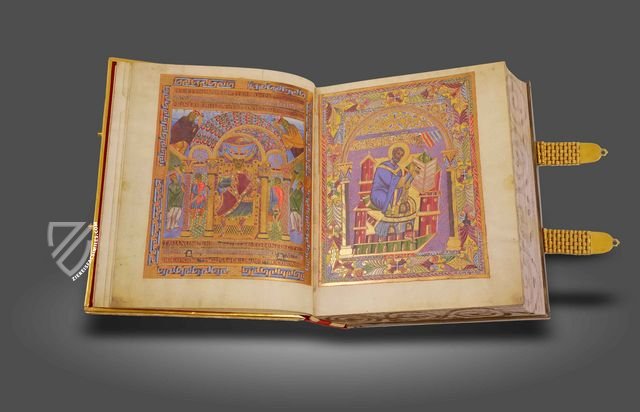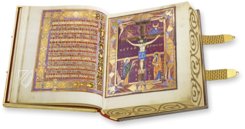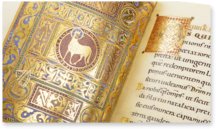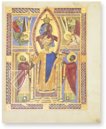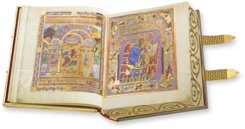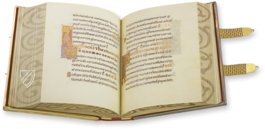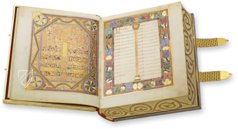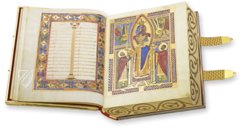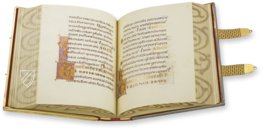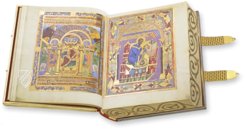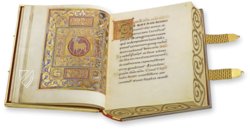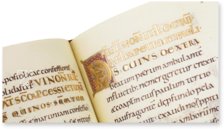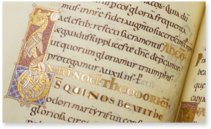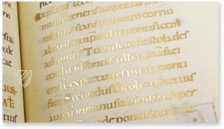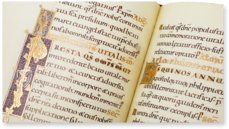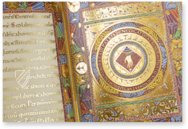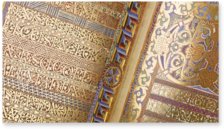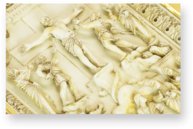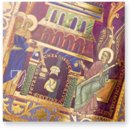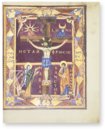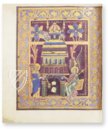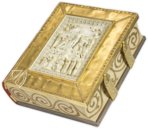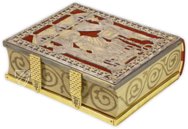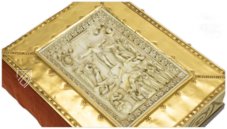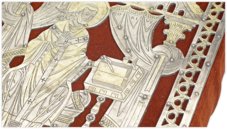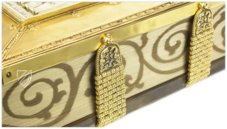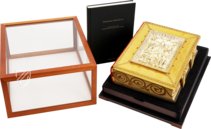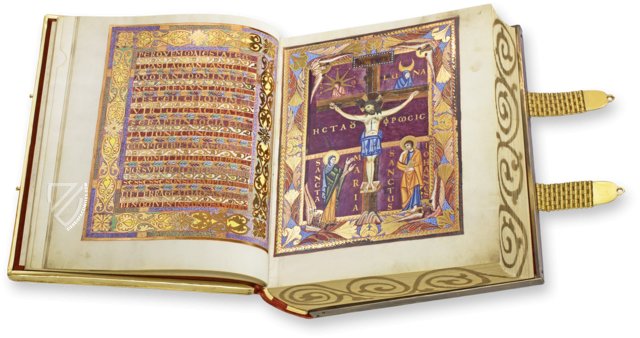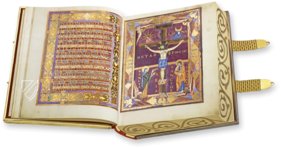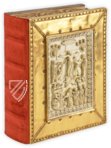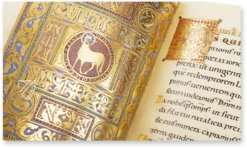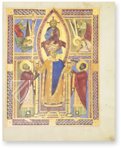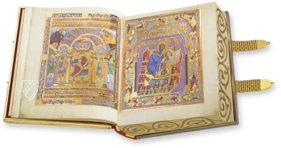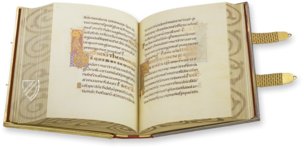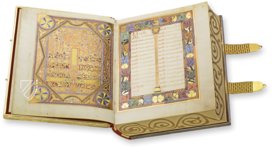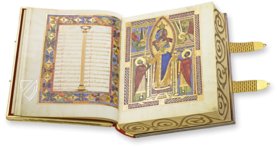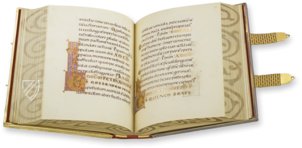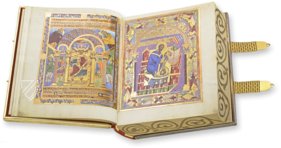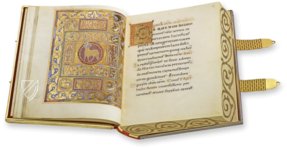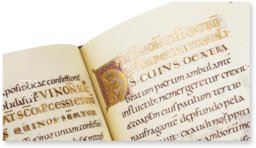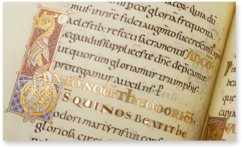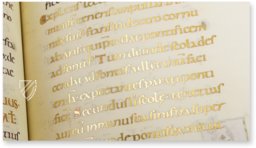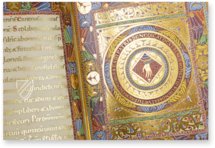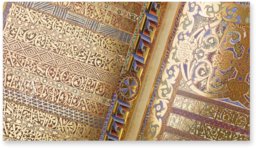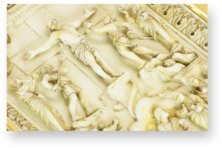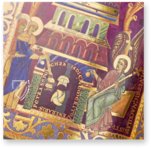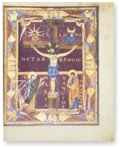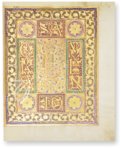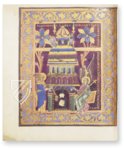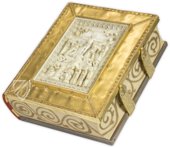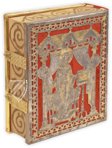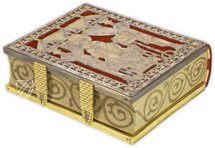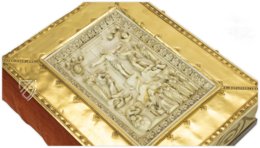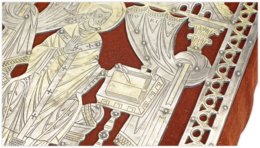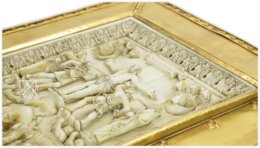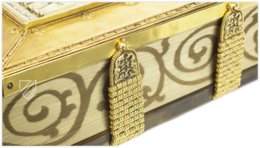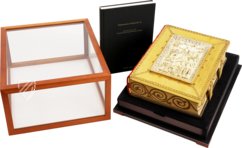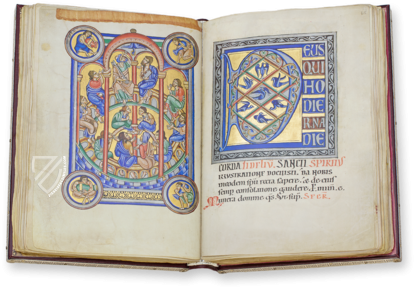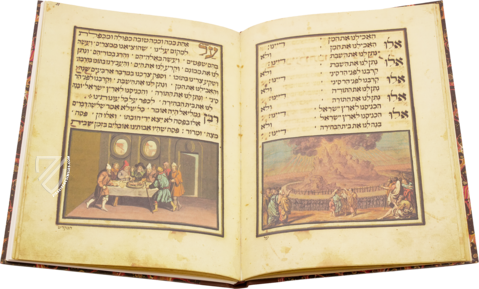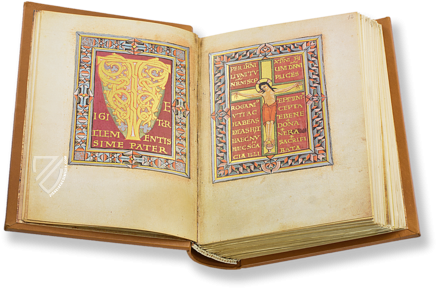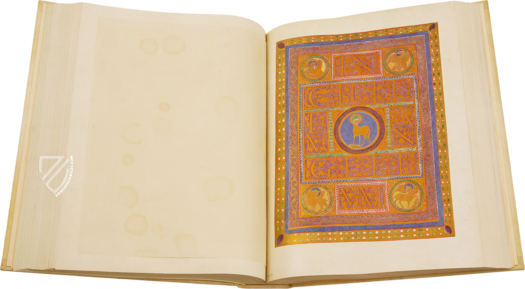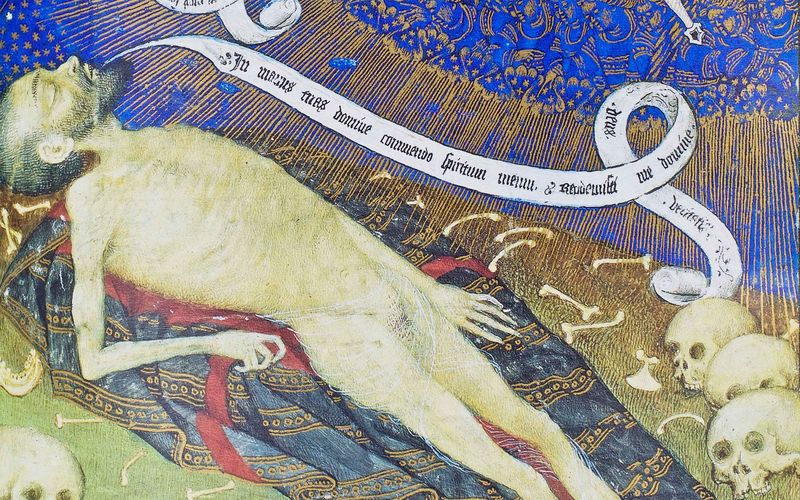Sacramentary of Henry II
(over 10,000€)
The magnificent sacramentary of Henry II was created in the famous scriptorium of the Regensburg monastery of St. Emmeram. The future Holy Roman Emperor Henry II donated the magnificent manuscript, decorated with elaborate ivory work, to the Bishopric of Bamberg, which he founded in 1007. The book treasure was used at festive church services in the cathedral there and was kept in the cathedral treasury in accordance with its value until Secularization. In addition to the richly ornamented calendar pages and texts of the high prayers, which are lavishly decorated with gold, it is especially the 14 masterly pictorial pages and the almost 350 decorative initials that constitute the artistic value of this important work of Ottonian book art.
Sacramentary of Henry II
This splendid sacramentary was donated by the later Roman-German Emperor Henry II to the Bishopric of Bamberg, which he founded in 1007. The Sacramentary of Henry II was used during solemn church services in the cathedral there and was housed in the cathedral treasury up to the time of Secularization. Along with the neatly ornamental and lushly designed with gold calendar pages and texts of the Eucharistic prayers, the 14 picture pages account for the artistic value of this important work of Ottonian illumination.
A Royal Donor
The striking coronation picture makes the royal donation obvious at first glance: Henry was crowned by the saintly Bishops Ulrich and Emmermam and invested with the Imperial Regalia – the Holy Lance and the Imperial Sword. The throne picture shows the king in his full power and glory. Additionally, the author’s picture of Gregory the Great, the legendary author of the sacramentary, aligns another great name with the book. The fact that the latter Emperor Henry II is still described here as REX indicates that allow us to draw conclusions about the dating the manuscript. The codex must have been made before 1014, the year of the imperial coronation. The reason for the commission of such a magnificent royal work could be the founding of the Bishopric of Bamberg in 1007 by Heinrich himself. The king donated the sacramentary to the cathedral there, which was created in the scriptorium of St. Emmermam’s Abbey in Regensburg and was presumably intended originally for the cathedral in Regensburg.
A Masterpiece from the Bavarian Center of Illumination
One of the most important centers of illumination in southern Germany during the Ottonian Era was located in the Danube-city of Regensburg. The scriptorium of St. Emmermam, the monastery of which commanded comprehensive stocks of valuable manuscripts, produced superb works such as the Uta Codex and the Sacramentary of Henry II. The magnificent manuscript from the golden age of Regensburg illumination shines especially with respect to its rich pictorial decoration. A total of 14 picture pages – including the already mentioned coronation, throne, and author pictures – along with 12 calendar pages and 9 framed pages of text written in gold ink with the Eucharistic prayers unfold a splendor worthy of a royal donation. Broad decorative frames, delicate ornamentation, a variety of colorful geometric and floral patterns, and not least the valuable gold surfaces form the basis for the array of artistic skills that the illuminators exahusted. The image composition is guided by Carolingian models. The artistic adornment was completed with the countless large and small initials that embellish the pages of text.
The Valuable Binding
The pages of the magnificent manuscript are protected by a binding that is worthy of the contents of the book. Set in gold is an ivory relief, which is probably datable from shortly before manuscript. Thematically it had Christ’s crucifixion in the upper register and shows the scene of the women at his tomb. The backside of the binding was adorned with partly gilded silver work, which shows Pope Gregory the Great who was already depicted in the book. The valuable sacramentary was used for masses in the Bamberg cathedral on the highest holidays and was a part of the Bamberg cathedral treasury in the following centuries. In the course of Secularization, the book came to Munich in 1803 where it is housed today in the Bavarian State Library.
Codicology
- Alternative Titles
- Regensburg Sacramentary
- Size / Format
- 718 pages / 29.5 × 24.2 cm
- Origin
- Germany
- Date
- 1007–1014
- Epochs
- Style
- Language
- Illustrations
- 21 pages with breath-taking ornament, 14 full-page miniatures (some of them on purple ground), nearly 350 elaborated gold and silver initials
- Patron
- Henry II, Holy Roman Emperor (972–1024)
- Previous Owners
- Bamberg Cathedral
Sacramentary of Henry II
Aedicula of The Holy Sepulchre
The shrine of Christ’s tomb is referred to as the aedicula, which is found in the Church of the Holy Sepulchre today. Three days after his Crucifixion, some of the disciples come to visit the tomb where Jesus was buried to anoint him with incense – they can be seen swinging a golden censer. Upon arrival, they discover the tomb is empty save for his burial shroud. An angel appears, telling them that Christ is risen and to go spread the good news to the other disciples.
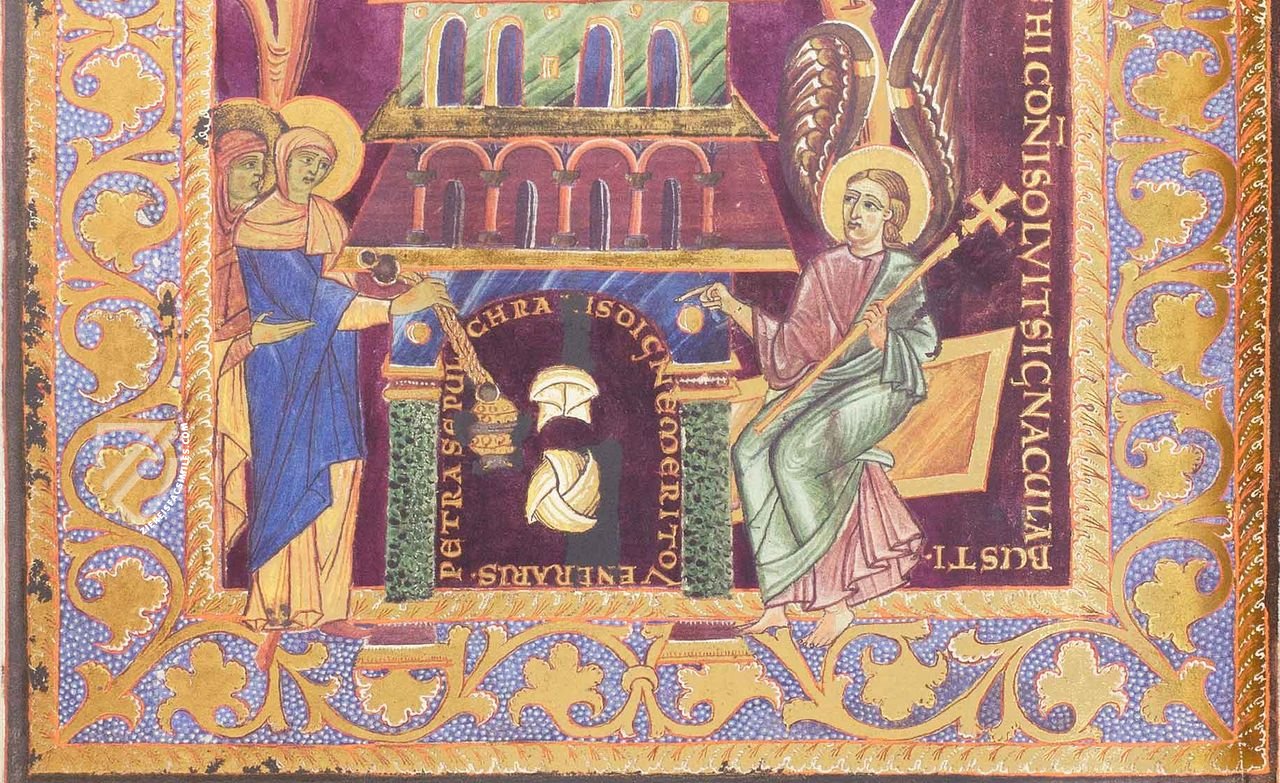
Sacramentary of Henry II
Coronation Miniature
This is the most well-known depiction of Henry II as well as the most significant image in the manuscript. Unfathomably rich in its adornment, incredibly refined in its artistic execution, it is the symbolism of the scene that is most significant. Floating above Henry in a mandorla, Christ in Majesty reaches down to crown him – one of the first assertions of divine rule in the West.
The banderole identifies Henry as REX, meaning that this image predates his imperial coronation. The King stands in front of four windows with his arms extended, holding the Imperial Sword in one hand and the Holy Lance in the other, which is marked as the Tree of Life by the small crucifix and golden globe atop it. Two bishops symbolically support Henry’s arms.
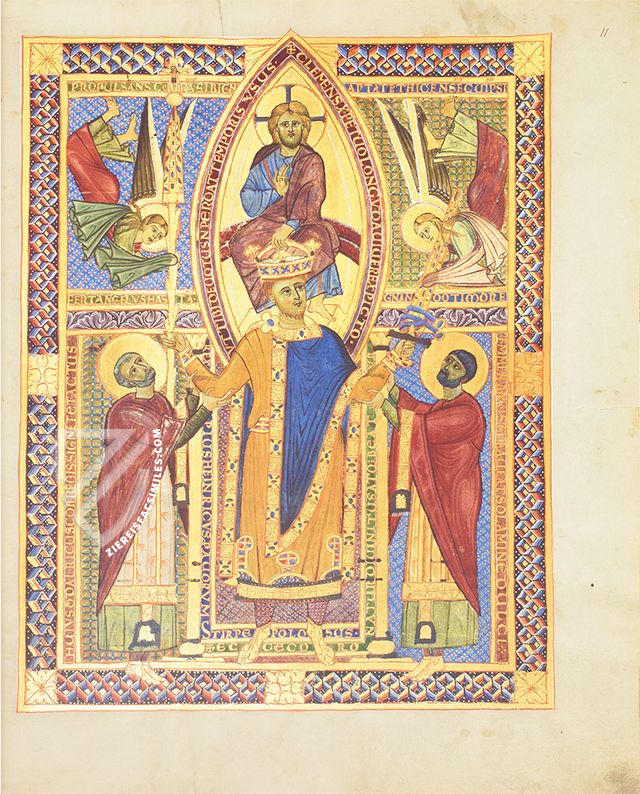
#1 Sakramentar Heinrichs II.
Language: German
(over 10,000€)
- Treatises / Secular Books
- Apocalypses / Beatus
- Astronomy / Astrology
- Bestiaries
- Bibles / Gospels
- Chronicles / History / Law
- Geography / Maps
- Saints' Lives
- Islam / Oriental
- Judaism / Hebrew
- Single Leaf Collections
- Leonardo da Vinci
- Literature / Poetry
- Liturgical Manuscripts
- Medicine / Botany / Alchemy
- Music
- Mythology / Prophecies
- Psalters
- Other Religious Books
- Games / Hunting
- Private Devotion Books
- Other Genres
- Afghanistan
- Armenia
- Austria
- Belgium
- Belize
- Bosnia and Herzegovina
- China
- Colombia
- Costa Rica
- Croatia
- Cyprus
- Czech Republic
- Denmark
- Egypt
- El Salvador
- Ethiopia
- France
- Germany
- Greece
- Guatemala
- Honduras
- Hungary
- India
- Iran
- Iraq
- Israel
- Italy
- Japan
- Jordan
- Kazakhstan
- Kyrgyzstan
- Lebanon
- Liechtenstein
- Luxembourg
- Mexico
- Morocco
- Netherlands
- Palestine
- Panama
- Peru
- Poland
- Portugal
- Romania
- Russia
- Serbia
- Spain
- Sri Lanka
- Sweden
- Switzerland
- Syria
- Tajikistan
- Turkey
- Turkmenistan
- Ukraine
- United Kingdom
- United States
- Uzbekistan
- Vatican City
- A. Oosthoek, van Holkema & Warendorf
- Aboca Museum
- Ajuntament de Valencia
- Akademie Verlag
- Akademische Druck- u. Verlagsanstalt (ADEVA)
- Aldo Ausilio Editore - Bottega d’Erasmo
- Alecto Historical Editions
- Alkuin Verlag
- Almqvist & Wiksell
- Amilcare Pizzi
- Andreas & Andreas Verlagsbuchhandlung
- Archa 90
- Archiv Verlag
- Archivi Edizioni
- Arnold Verlag
- ARS
- Ars Magna
- ArtCodex
- AyN Ediciones
- Azimuth Editions
- Badenia Verlag
- Bärenreiter-Verlag
- Belser Verlag
- Belser Verlag / WK Wertkontor
- Benziger Verlag
- Bernardinum Wydawnictwo
- BiblioGemma
- Biblioteca Apostolica Vaticana (Vaticanstadt, Vaticanstadt)
- Bibliotheca Palatina Faksimile Verlag
- Bibliotheca Rara
- Boydell & Brewer
- Bramante Edizioni
- Bredius Genootschap
- Brepols Publishers
- British Library
- C. Weckesser
- Caixa Catalunya
- Canesi
- CAPSA, Ars Scriptoria
- Caratzas Brothers, Publishers
- Carus Verlag
- Casamassima Libri
- Centrum Cartographie Verlag GmbH
- Chavane Verlag
- Christian Brandstätter Verlag
- Circulo Cientifico
- Club Bibliófilo Versol
- Club du Livre
- CM Editores
- Collegium Graphicum
- Collezione Apocrifa Da Vinci
- Comissão Nacional para as Comemorações dos Descobrimentos Portugueses
- Coron Verlag
- Corvina
- CTHS
- D. S. Brewer
- Damon
- De Agostini/UTET
- De Nederlandsche Boekhandel
- De Schutter
- Deuschle & Stemmle
- Deutscher Verlag für Kunstwissenschaft
- DIAMM
- Droz
- E. Schreiber Graphische Kunstanstalten
- Ediciones Boreal
- Ediciones Grial
- Ediclube
- Edições Inapa
- Edilan
- Editalia
- Edition Deuschle
- Edition Georg Popp
- Edition Leipzig
- Edition Libri Illustri
- Editiones Reales Sitios S. L.
- Éditions de l'Oiseau Lyre
- Editions Medicina Rara
- Editorial Casariego
- Editorial Mintzoa
- Editrice Antenore
- Editrice Velar
- Edizioni Edison
- Egeria, S.L.
- Eikon Editores
- Electa
- Emery Walker Limited
- Enciclopèdia Catalana
- Eos-Verlag
- Ephesus Publishing
- Ernst Battenberg
- Eugrammia Press
- Extraordinary Editions
- Fackelverlag
- Facsimila Art & Edition
- Facsimile Editions Ltd.
- Facsimilia Art & Edition Ebert KG
- Faksimile Verlag
- Feuermann Verlag
- Folger Shakespeare Library
- Franco Cosimo Panini Editore
- Friedrich Wittig Verlag
- Fundación Hullera Vasco-Leonesa
- G. Braziller
- Gabriele Mazzotta Editore
- Gebr. Mann Verlag
- Gesellschaft für graphische Industrie
- Getty Research Institute
- Giovanni Domenico de Rossi
- Giunti Editore
- Graffiti
- Grafica European Center of Fine Arts
- Guido Pressler
- Guillermo Blazquez
- Gustav Kiepenheuer
- H. N. Abrams
- Harrassowitz
- Harvard University Press
- Helikon
- Hendrickson Publishers
- Henning Oppermann
- Herder Verlag
- Hes & De Graaf Publishers
- Hoepli
- Holbein-Verlag
- Houghton Library
- Hugo Schmidt Verlag
- Idion Verlag
- Il Bulino, edizioni d'arte
- ILte
- Imago
- Insel Verlag
- Insel-Verlag Anton Kippenberger
- Instituto de Estudios Altoaragoneses
- Instituto Nacional de Antropología e Historia
- Introligatornia Budnik Jerzy
- Istituto dell'Enciclopedia Italiana - Treccani
- Istituto Ellenico di Studi Bizantini e Postbizantini
- Istituto Geografico De Agostini
- Istituto Poligrafico e Zecca dello Stato
- Italarte Art Establishments
- Jan Thorbecke Verlag
- Johnson Reprint Corporation
- Josef Stocker
- Josef Stocker-Schmid
- Jugoslavija
- Karl W. Hiersemann
- Kasper Straube
- Kaydeda Ediciones
- Kindler Verlag / Coron Verlag
- Kodansha International Ltd.
- Konrad Kölbl Verlag
- Kurt Wolff Verlag
- La Liberia dello Stato
- La Linea Editrice
- La Meta Editore
- Lambert Schneider
- Landeskreditbank Baden-Württemberg
- Leo S. Olschki
- Les Incunables
- Liber Artis
- Library of Congress
- Libreria Musicale Italiana
- Lichtdruck
- Lito Immagine Editore
- Lumen Artis
- Lund Humphries
- M. Moleiro Editor
- Maison des Sciences de l'homme et de la société de Poitiers
- Manuscriptum
- Martinus Nijhoff
- Maruzen-Yushodo Co. Ltd.
- MASA
- Massada Publishers
- McGraw-Hill
- Metropolitan Museum of Art
- Militos
- Millennium Liber
- Müller & Schindler
- Nahar - Stavit
- Nahar and Steimatzky
- National Library of Wales
- Neri Pozza
- Nova Charta
- Oceanum Verlag
- Odeon
- Orbis Mediaevalis
- Orbis Pictus
- Österreichische Staatsdruckerei
- Oxford University Press
- Pageant Books
- Parzellers Buchverlag
- Patrimonio Ediciones
- Pattloch Verlag
- PIAF
- Pieper Verlag
- Plon-Nourrit et cie
- Poligrafiche Bolis
- Presses Universitaires de Strasbourg
- Prestel Verlag
- Princeton University Press
- Prisma Verlag
- Priuli & Verlucca, editori
- Pro Sport Verlag
- Propyläen Verlag
- Pytheas Books
- Quaternio Verlag Luzern
- Reales Sitios
- Recht-Verlag
- Reichert Verlag
- Reichsdruckerei
- Reprint Verlag
- Riehn & Reusch
- Roberto Vattori Editore
- Rosenkilde and Bagger
- Roxburghe Club
- Salerno Editrice
- Saltellus Press
- Sandoz
- Sarajevo Svjetlost
- Schöck ArtPrint Kft.
- Schulsinger Brothers
- Scolar Press
- Scrinium
- Scripta Maneant
- Scriptorium
- Shazar
- Siloé, arte y bibliofilia
- SISMEL - Edizioni del Galluzzo
- Sociedad Mexicana de Antropología
- Société des Bibliophiles & Iconophiles de Belgique
- Soncin Publishing
- Sorli Ediciones
- Stainer and Bell
- Studer
- Styria Verlag
- Sumptibus Pragopress
- Szegedi Tudomànyegyetem
- Taberna Libraria
- Tarshish Books
- Taschen
- Tempus Libri
- Testimonio Compañía Editorial
- Thames and Hudson
- The Clear Vue Publishing Partnership Limited
- The Facsimile Codex
- The Folio Society
- The Marquess of Normanby
- The Richard III and Yorkist History Trust
- Tip.Le.Co
- TouchArt
- TREC Publishing House
- TRI Publishing Co.
- Trident Editore
- Tuliba Collection
- Typis Regiae Officinae Polygraphicae
- Union Verlag Berlin
- Universidad de Granada
- University of California Press
- University of Chicago Press
- Urs Graf
- Vallecchi
- Van Wijnen
- VCH, Acta Humaniora
- VDI Verlag
- VEB Deutscher Verlag für Musik
- Verlag Anton Pustet / Andreas Verlag
- Verlag Bibliophile Drucke Josef Stocker
- Verlag der Münchner Drucke
- Verlag für Regionalgeschichte
- Verlag Styria
- Vicent Garcia Editores
- W. Turnowski Ltd.
- W. Turnowsky
- Waanders Printers
- Wiener Mechitharisten-Congregation (Wien, Österreich)
- Wissenschaftliche Buchgesellschaft
- Wissenschaftliche Verlagsgesellschaft
- Wydawnictwo Dolnoslaskie
- Xuntanza Editorial
- Zakład Narodowy
- Zollikofer AG

